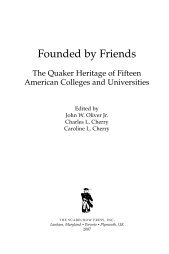Separate Realities: The Dream and the Iceberg - Scarecrow Press
Separate Realities: The Dream and the Iceberg - Scarecrow Press
Separate Realities: The Dream and the Iceberg - Scarecrow Press
Create successful ePaper yourself
Turn your PDF publications into a flip-book with our unique Google optimized e-Paper software.
80 Chapter 2<br />
Federal Tax Cuts: 2001 to 2006 During <strong>the</strong> first five years of his administration,<br />
President Bush signed into law five major tax cuts (excluding <strong>the</strong> Katrina<br />
Emergency Tax Relief Act of 2005). Three substantially reduced federal<br />
taxes for privileged-class individuals <strong>and</strong> families (or extended reductions)<br />
<strong>and</strong> two reduced federal taxes for corporations (which also benefited <strong>the</strong> privileged<br />
class, but a bit more indirectly). By <strong>the</strong> midpoint of Bush’s second term,<br />
his administration had enacted tax cuts totaling $1.65 trillion, plus ano<strong>the</strong>r<br />
$1.6 trillion by 2016 if all tax cuts were made permanent. 189 <strong>The</strong> following<br />
paragraphs briefly describe <strong>the</strong> five major tax cuts <strong>and</strong> summarize <strong>the</strong>ir effects.<br />
In 2001, <strong>the</strong> Economic Growth <strong>and</strong> Tax Relief Reconciliation Act of 2001<br />
was passed by Congress with Republican <strong>and</strong> Democratic support; this law reduced<br />
federal taxes on individuals <strong>and</strong> families by $1.35 trillion (over nine<br />
years), with most of <strong>the</strong> reductions going to <strong>the</strong> top 20 percent <strong>and</strong> top 1 percent<br />
income groups. 190 On May 28, 2003, President Bush signed <strong>the</strong> Jobs <strong>and</strong><br />
Growth Tax Relief <strong>and</strong> Reconciliation Act of 2003. This act “lowered <strong>the</strong> top<br />
tax rate on corporate stock dividends from 35 percent to 15 percent, <strong>and</strong> reduced<br />
<strong>the</strong> top capital gains tax rate from 20 percent to 15 percent.” 191 A 2006<br />
analysis revealed that 71 percent of <strong>the</strong> economic benefits of this act went<br />
to individuals with annual incomes over $200,000 <strong>and</strong> nearly 43 percent of<br />
<strong>the</strong> capital gains <strong>and</strong> dividend tax cuts went to tax filers with incomes over<br />
$1 million. 192 On May 17, 2006, Bush signed <strong>the</strong> Tax Increase Prevention <strong>and</strong><br />
Reconciliation Act of 2005. This third tax cut extended <strong>the</strong> 2003 capital gains<br />
<strong>and</strong> stock dividend tax cuts through 2010. 193<br />
Corporate taxes were reduced by <strong>the</strong> Job Creation <strong>and</strong> Worker Assistance Act<br />
of 2002 <strong>and</strong> <strong>the</strong> American Job Creation Act of 2004. Both acts favored privileged-class<br />
interests. <strong>The</strong> 2002 act provided workers with additional unemployment<br />
insurance benefits totaling $14 billion, but U.S. corporations were<br />
<strong>the</strong> biggest winners receiving $114 billion in tax cuts. 194 <strong>The</strong> 2004 act was supported<br />
by 428 major U.S. corporations <strong>and</strong> trade associations. 195 It provided<br />
$137 billion in tax cuts to large segments of <strong>the</strong> business community, including<br />
manufacturers <strong>and</strong> multinational companies. 196<br />
<strong>The</strong> Political Dimension of <strong>the</strong> Class War: Many Fronts <strong>The</strong> political dimension<br />
of <strong>the</strong> class war goes far beyond tax cuts favoring <strong>the</strong> privileged class.<br />
As we will see in later chapters, this dimension of <strong>the</strong> class war is fought on<br />
many fronts. Republican officeholders are typically <strong>the</strong> most openly enthusiastic<br />
supporters of privileged-class interests. But <strong>the</strong> enactment of many features<br />
of <strong>the</strong> anti-working-class social, labor, <strong>and</strong> trade policies of <strong>the</strong> Bush administration<br />
via recent congressional votes on a wide range of issues (e.g., see chapter<br />
4: workplace safety, bankruptcy “reform,” class action litigation “reform,”<br />
Central American trade policy) illustrate <strong>the</strong> political reality that many Democrats<br />
routinely support privileged-class-favored policies. This was also true in<br />
<strong>the</strong> previous administration; for example, President Clinton worked diligently<br />
to ensure <strong>the</strong> passage of anti-working-class legislation such as <strong>the</strong> North American<br />
Free Trade Agreement in 1993 <strong>and</strong> <strong>the</strong> so-called 1996 welfare reform act.
















